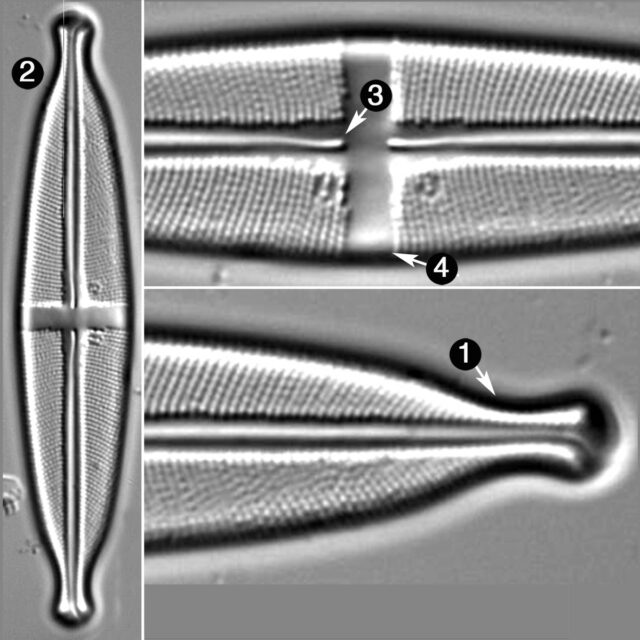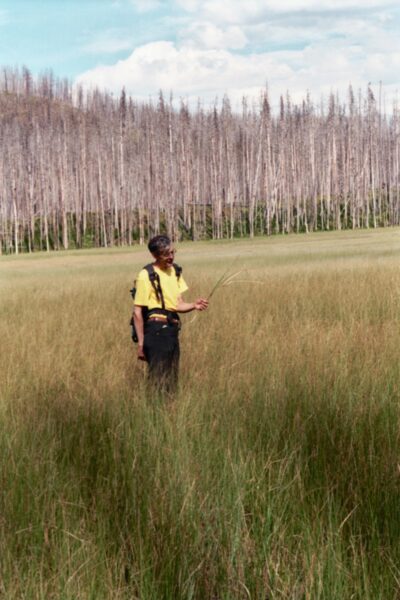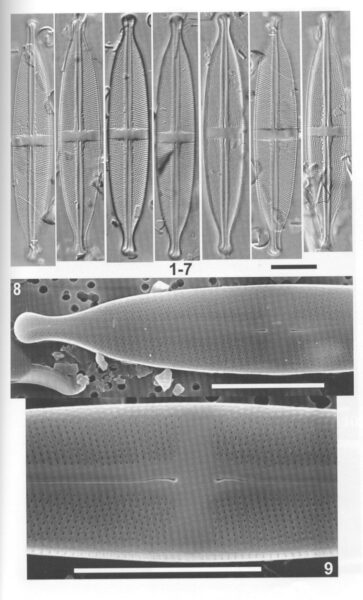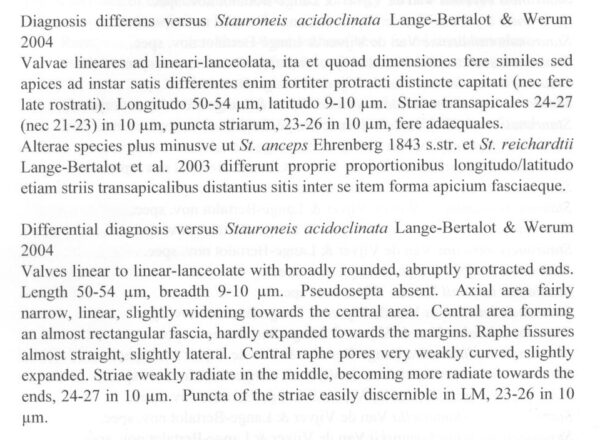Stauroneis acidoclinatopsis
-
Category
-
Length Range57-61 µm
-
Width Range10-12 µm
-
Striae in 10 µm23-25
-
Reported AsStauroneis anceps (Krammer and Lange-Bertalot 1986)
-
ContributorLoren Bahls - Dec 2011
-
ReviewerSarah Spaulding - Apr 2012
Identification
Description
Valves are linear-lanceolate with abruptly protracted, capitate apices. The axial area is narrow, becoming more narrow near the valve ends. It is slightly wider near the central area, a rectangular stauros. External raphe fissures are weakly lateral and nearly straight. Proximal raphe ends are weakly curved and slightly expanded. Striae are gently radiate near the valve middle, becoming more strongly radiate towards the apices. Areolae are easily distinguished in LM and number 24–28 in 10 µm.
Autecology
Stauroneis acidoclinatopsis has been recorded from five lakes and wetlands in the Northern Rockies, where it prefers circumneutral waters of low conductance. These waters have a pH range of 5.5 to 8.5 and a conductivity range of 10 to 257 µS/cm. This species was described from material collected at Qeqertarsuaq, West Greenland (69 degrees north latitude), where it was found in a small shallow pool with slightly acid water (pH 6.0), low conductance (<50 µS/cm), and very low nutrient levels (Van de Vijver et al. 2004).
-
Size Range, µm3
-
Motility
-
Attachment
-
Habitat
-
Colony
-
Waterbody
-
Distribution
- Learn more about this
Original Description
Valves linear to linear-lanceolate with broadly rounded, abruptly protracted ends. Length 50-54 µm, breadth 9-10 µm. Pseudosepta absent. Axial area fairly narrow, linear, slightly widening towards the central area. Central area forming an almost rectangular fascia, hardly expanded towards the margins. Raphe fissures almost straight, slightly lateral. Central raphe pores very weakly curved, slightly expanded. Striae weakly radiate in the middle, becoming more radiate towards the ends, 24-27 in 10 µm. Puncta of the striae easily discernible in LM, 23-26 in 10 µm.
-
AuthorVan de Vijver and Lange-Bert. 2004
-
Length Range50-54 µm
-
Width9-10 µm
-
Striae in 10µm24-27
Citations & Links
Citations
Links
Cite This Page
Bahls, L. (2011). Stauroneis acidoclinatopsis. In Diatoms of North America. Retrieved April 19, 2024, from https://diatoms.org/species/stauroneis_acidoclinatopsis
Responses
The 15 response plots show an environmental variable (x axis) against the relative abundance (y axis) of Stauroneis acidoclinatopsis from all the stream reaches where it was present. Note that the relative abundance scale is the same on each plot. Explanation of each environmental variable and units are as follows:
ELEVATION = stream reach elevation (meters)
STRAHLER = distribution plot of the Strahler Stream Order
SLOPE = stream reach gradient (degrees)
W1_HALL = an index that is a measure of streamside (riparian) human activity that ranges from 0 - 10, with a value of 0 indicating of minimal disturbance to a value of 10 indicating severe disturbance.
PHSTVL = pH measured in a sealed syringe sample (pH units)
log_COND = log concentration of specific conductivity (µS/cm)
log_PTL = log concentration of total phosphorus (µg/L)
log_NO3 = log concentration of nitrate (µeq/L)
log_DOC = log concentration of dissolved organic carbon (mg/L)
log_SIO2 = log concentration of silicon (mg/L)
log_NA = log concentration of sodium (µeq/L)
log_HCO3 = log concentration of the bicarbonate ion (µeq/L)
EMBED = percent of the stream substrate that is embedded by sand and fine sediment
log_TURBIDITY = log of turbidity, a measure of cloudiness of water, in nephelometric turbidity units (NTU).
DISTOT = an index of total human disturbance in the watershed that ranges from 1 - 100, with a value of 0 indicating of minimal disturbance to a value of 100 indicating severe disturbance.

Stauroneis acidoclinatopsis
- Apices abruptly protracted, capitate
- Valves linear-lanceolate
- Proximal raphe ends weakly curved and expanded
- Stauros rectangular
Valves of S. acidoclinatopsis are linear-lanceolate with abruptly protracted, capitate apices. Valves are 10-12 µm wide and greater than 50 µm long. Proximal raphe ends are weakly curved and expanded. The stauros is rectangular.
 Diatoms of North America
Diatoms of North America






